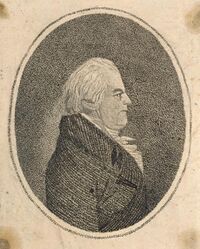Biography:Edward Riley: Difference between revisions
No edit summary |
No edit summary |
||
| (One intermediate revision by the same user not shown) | |||
| Line 13: | Line 13: | ||
---- | ---- | ||
<p><font face="sans-serif" size="4"> | <p><font face="sans-serif" size="4"> | ||
'''EDWARD RILEY''' (1769-1829) was an English engraver and publisher who had a business in London from 1795 to 1803, after which he emigrated to the United States. Arriving in New York, he established himself as a teacher of music and singing, advertising lessons on the German flute, patent flagiolet [sic], piano and singing. He also worked for a time as an engraver for established music publishers John Paff and John Appel. However, in 1811 he established his own publishing business. Riley also sold instruments from his premises. | '''EDWARD RILEY''' (1769-1829) was an English engraver and publisher who had a business in London from 1795 to 1803, after which he emigrated to the United States. Arriving in New York, he established himself as a teacher of music and singing, advertising lessons on the German flute, patent flagiolet [sic], piano and singing. He also worked for a time as an engraver for established music publishers John Paff and John Appel. However, in 1811 he established his own music publishing business. Riley also sold instruments and manufactured instruments from his premises at 29 Chatham Street. His three sons followed him into the family business and two of them, Frederick and and Henry, later opened shops nearby. His two daughters married John Firth and William Hall, respectively, who had been apprenticed in Riley's shop. They founded the firm of Firth & Hall in 1821 and became prominent manufacturers and publishers in their own right. Following Edward's death in 1829 his sons (one also called Edward Riley) carried on the business until it became J.F. Gould & Co. in 1851. | ||
<br> | <br> | ||
<br> | <br> | ||
Edward Riley Sr. wrote a treatise on flute playing, '''Riley's New Instructions for the German Flute''' (1811), and a produced a four-volume collection on music entitled '''Riley’s Flute Melodies,''' published in serial form in 1814 and 1817 and together in 1820. | |||
<br> | <br> | ||
<br> | <br> | ||
Latest revision as of 22:34, 4 September 2024
Edward Riley
| |
|---|---|
| Given name: | Edward |
| Middle name: | R. |
| Family name: | Riley |
| Place of birth: | |
| Place of death: | New York |
| Year of birth: | 1769 |
| Year of death: | 1829 |
| Profile: | Editor, Collector, Composer, Engraver, Musician, Publisher |
| Source of information: | https://mds.marshall.edu/cgi/viewcontent.cgi?referer=https://www.google.com/&httpsredir=1&article=1000&context=music faculty |
Biographical notes
EDWARD RILEY (1769-1829) was an English engraver and publisher who had a business in London from 1795 to 1803, after which he emigrated to the United States. Arriving in New York, he established himself as a teacher of music and singing, advertising lessons on the German flute, patent flagiolet [sic], piano and singing. He also worked for a time as an engraver for established music publishers John Paff and John Appel. However, in 1811 he established his own music publishing business. Riley also sold instruments and manufactured instruments from his premises at 29 Chatham Street. His three sons followed him into the family business and two of them, Frederick and and Henry, later opened shops nearby. His two daughters married John Firth and William Hall, respectively, who had been apprenticed in Riley's shop. They founded the firm of Firth & Hall in 1821 and became prominent manufacturers and publishers in their own right. Following Edward's death in 1829 his sons (one also called Edward Riley) carried on the business until it became J.F. Gould & Co. in 1851.
Edward Riley Sr. wrote a treatise on flute playing, Riley's New Instructions for the German Flute (1811), and a produced a four-volume collection on music entitled Riley’s Flute Melodies, published in serial form in 1814 and 1817 and together in 1820.
For more on Riley, see Wendell Dobbs' article "An Early American Family of Flutists", Faculty Research, Paper 1, 2008, Marshall University [1].
